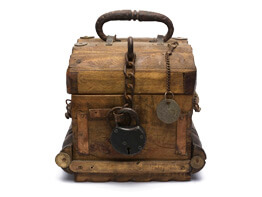Time is elusive. Humans are obsessed with it: we pass it, save it, waste it, wish it away, squander it, mark it, buy time, make time, kill time and run out of time. It’s all about time!
Yet how do we mark and preserve time? One way is to create a time capsule to capture a family’s era. I decided to create our family’s time capsule after covering a story about St. Margaret, Bel Air, opening a 30-year-old time capsule in January 2006 and sealing a new one. As they showed me the contents, I imagined what items I would select to place inside of my own time capsule.
So I hosted a time capsule party in February 2006 for my large Italian family. Toting along their contributions, more than 30 attended. We ceremonially placed our items inside a big plastic container and attached a letter “to the future” on the outside. Then we all signed it.
The family repeatedly asked, “Where will you bury it?” Before the party, they were fixated on what type of container I would select. A time capsule doesn’t have to be any specific container nor does it have to be buried – it may never be found. (Right now our time “container” is actually buried under my home office clutter.) Our goal was simply to leave a small legacy behind for our grandchildren and great-grandchildren to glimpse the people we are today.
Among some of the effects we placed inside were our business cards and career mementos, a journal of our 2001 family trip to Italy to visit cousins, the eulogy from our grandmother’s funeral, the family tree, photos, handwritten letters to a future generation, wedding mementos, a family recipe book, Sept. 11 hero bracelets, and a bottle of Italian wine.
One young cousin, Sarina Mossa, then 12, of St. Francis de Sales, Abingdon, and St. Margaret, Bel Air, captured the concept that creating a time capsule wasn’t about the container or its burial, or the stuff inside.
In a letter to our future family, she wrote, “… for you to know what this stuff is, you have to look beyond what you see … from cousins to grandparents to great-aunts and uncles, this is nothing other than love … whether we are alive when you read this, or if some of us took our trip to heaven, the love has remained through the years, through our hearts and through this family time capsule. No matter what happens, we have each other, and in the end that’s all anyone really needs.”


